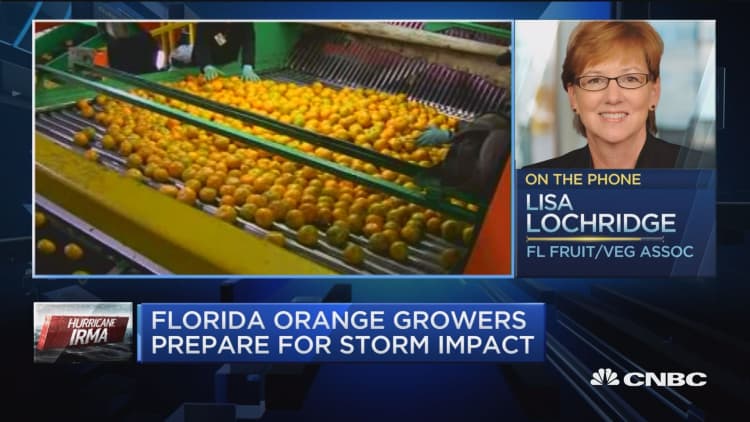The U.S. Department of Agriculture is expected Thursday morning to provide its first forecast for Florida citrus production for the 2017-2018 season. Many expect it will be the smallest crop since the 1940s.
"It could be pretty bad — lowest since around 1946," said Gene McAvoy, an agriculture expert with the University of Florida. "About 70 percent of what they were projecting is lost across the board."
A decline in fresh citrus production in California and storm damage from Florida's crop is expected to result in higher prices for oranges this season at the nation's supermarkets.
In Florida, tropical winds from last month's Hurricane Irma damaged large portions of the state's citrus production and total losses are expected to exceed $760 million, according to the state's agriculture agency. Much of Florida's crop goes to orange juice, but some of the fruit is for the fresh market.
Ahead of the USDA's citrus forecast, orange juice futures for November in New York rose less than 0.5 percent to settle Wednesday at $1.613 a pound. On an intraday basis, though, the contract had swings of more than 2 percent.
The November orange juice futures contract is up about 20 percent since the end of August and at levels not seen since the spring.

"We've actually taken out the highs from the hurricane rise," said Jack Scoville, vice president for Price Futures Group in Chicago. He noted that the futures made it to about $1.60 a pound as Hurricane Irma was hitting but once the storm passed prices fell back to around $1.42 a pound.
Scoville said the orange juice futures market essentially is on edge due to "a hugely low estimate" from the Florida Citrus Mutual, a trade organization.
Before Hurricane Irma, Florida was expecting to harvest more than 75 million boxes worth of oranges, according to the Florida Department of Citrus. The Florida Citrus Mutual on Tuesday estimated the current crop will come in around 31 million boxes.
"If the crop is anywhere near that small, even with the lousy [orange juice] demand outlook and things like that, we'll have a chance to push the market up around $2 [a pound]," said Scoville.
McAvoy said Florida's citrus losses are averaging about 70 percent statewide but in some areas of the southern region the loss may be upwards of 90 percent because that's where the hurricane made landfall and winds were strongest. "As you move north in the state, it goes lower," he said.
Some citrus-growing areas faced peak wind gusts between about 60 and 80 miles per hour during Hurricane Irma. When including all agriculture damage statewide, the state estimates total losses to production exceeding $2.5 billion.
California also has suffered due to weather-related impacts. Heavy rains in the spring helped end the state's historic drought in most agricultural regions but also caused loss of blooms. Also, citrus trees continue to feel the impact of years of drought conditions as well as salt accumulation in the irrigation water.
In California, navel production for the 2017-2018 season is forecast to be down 11 percent from the prior season, according to USDA estimates released last month. The state's navel crop represents around 40 percent of the state's total citrus production.
"The California citrus crop is smaller than it's been in the past five or six years," said Joel Nelsen, president of the California Citrus Mutual, which represents more than 80 percent of the state's citrus industry. "We're attributing that to two things: the rain in the spring knocked off a lot of blossoms and ... trees are still tired from the drought."
Still, Nelsen expects there will be enough mandarin and California navel oranges to meet demand for the winter holidays but prices will be higher due to Florida's woes.
"The unfortunate situation in Florida has reduced what little fresh tonnage they had in terms of oranges, so our prices are going to be a little higher this year."
A check of several large national retailers found citrus prices on such varieties as clementine oranges haven't started rising substantially, and some expect global supply from Morocco and Spain may keep any increases in the low single digits.
"We don't feel like we're going to have a whole lot of problem there," said a top-three retail fruit buyer, who didn't want to be identified.
Added the buyer, "We can also ship [clementine oranges] from Spain, from Morocco and from some other areas into the East Coast — and we don't have to utilize the California crop if it's a little bit short. For us, it's a global market and not just singular to a state. And globally we're looking fine."
Indeed, Nelsen concedes any citrus price increases are unlikely to be substantial due to the global nature of the citrus production.
"You can't go too high, because then consumers switch to alternative product," said Nelsen. "But you'll still see a higher price on California navel oranges in the market this year."
The price of fresh grapefruit also is likely to be higher this year since Florida lost a huge percentage of the crop. While Florida ranks second in orange juice production to Brazil, the Sunshine State's grapefruit accounts for more than half of the U.S. production, according to USDA data.
Florida's orange crop production peaked about 15 years ago due in part to "citrus greening" disease.
Last year, a study by the University of Florida estimated between 80 and 90 percent of the state's citrus acreage was infected by citrus greening, which is spread primarily by an insect the size of a grain of rice. Major citrus growing regions of California also are fighting against citrus greening, which is formally known as huanglongbing.
WATCH: Irma crushes Florida citrus crop



